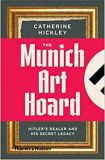The Munich Art Hoard: Hitler's Dealer and His Secret Legacy by Catherine Hickley
| The Munich Art Hoard: Hitler's Dealer and His Secret Legacy by Catherine Hickley | |
|
| |
| Category: History | |
| Reviewer: John Lloyd | |
| Summary: This book covers the Cornelius Gurlitt story and so much more, as we see how a man was found to have millions of Euros worth of German art stashed about his flat – and what it might mean for global diplomacy. | |
| Buy? Yes | Borrow? Yes |
| Pages: 272 | Date: July 2016 |
| Publisher: Thames and Hudson Ltd | |
| External links: Author's website | |
| ISBN: 9780500292570 | |
|
| |
One of the most newsworthy events in modern art history happened seemingly by chance. When tax police raided the house of an aged man in Munich it was because they assumed he had been moving too much money about and paying no tax – this six months after he was seen on the train between Bavaria and Switzerland with 'nearly too much' cash. The investigators had no case, but he had something much more complex and rich – a massive legacy of 20th Century German and European art. But that collection had to have an origin – one of dubious and at times nefarious beginnings, and one that could have quite a rich and convoluted background. Hickley, in these pages, gives us much in the way of context as well as ironing out those convolutions, so this story is both of interest to Nazi historians and art scholars – as well as to those larger numbers who just like a good story told well.
And this story is told very well. The spread of names mentioned, both on the canvas, and in the negotiating rooms as the artworks gets purchased, may be large enough to justify trying to plough through these closely-typed pages as quickly as you can, but the narrative drive gives us the same impetus as well. From the beginnings of Hildebrand Gurlitt and his support as a gallery owner and museum boss for Die Brucke artists, to him traipsing across western Europe snaffling up riches Hitler would have admired for what he assumed would be a world-beating gallery in his home town of Linz, Austria – the scope is always a grand one. And the time line of the story is ever-present, too – we get a month-by-month account of the variations in Hildebrand's career, as well as an ever-present feeling of regret that so much of the artwork discussed has disappeared for us here and now. Die Brucke is, by chance, quite prominent in Leicester Museum's collections, but, even if a lot of what made up the hoard was just a scratching on paper and not what many would call a full artwork, given the tales of treasures vanished, masterpieces unaccounted for, and of wholescale warehousing and burning, there is a gaping hole in the world from what disappeared during this story.
Beyond that, too, we have the morals of Gurlitt. He was an avowed anti-Nazi, on a quiet and pacifist scale – even to the point of chopping down the museum flagpole before he had to face the mandate of running up the Swastika. But he also managed to find no qualm about fleecing fleeing Jews of artworks in buying them for perhaps a tenth of the real value, and making a 25% mark-up within weeks at most; and his wartime activity bolstering the Nazi's collection of favoured artworks on behalf of Hitler himself, even if they never met, shows business acumen above political and humanitarian sentiment. It's no wonder the real, moral ownership of so much art these days is a hot potato – and as the later chapters here suggest, there is a feast of roast spuds in this oven.
Yes, this book might perhaps try too hard to leave behind the headlines and make itself the definitive volume on art restitution – the giving back payment or artwork to those from whom it was stolen or bought at piecemeal rates. I however have to admire the sterling research in evidence, and only rarely does it read as too authoritative, and never unwelcomingly so. We take a long time to reach Cornelius Gurlitt – the most recent private guardian of the artworks, and from then on see the whole restitution story laid out. For so long it was deemed the fault of the estate of Holocaust victims that they had not asked for their property back – while it was impossible for them to know whom to ask. Several countries had heinous statutes of limitations, after which ownership was deemed fixed, and never tainted by prior Nazi crime. It's a very long story looking ahead to the end when everything has been resolved; for now, while slightly dry here and there, I did think this book opened the window onto this subject the widest, and offered just what the intelligent reader wanted on the subject.
I must thank the publishers for my review copy.
File near Nazi Millionaires: The Allied Search for Hidden SS Gold by Kenneth D Alford and Theodore P Savas, which looks at the metallic wealth left by the Holocaust victims.
Please share on: ![]() Facebook,
Facebook, ![]() Twitter and
Twitter and
![]() Instagram
Instagram
![]() You can read more book reviews or buy The Munich Art Hoard: Hitler's Dealer and His Secret Legacy by Catherine Hickley at Amazon.co.uk Amazon currently charges £2.99 for standard delivery for orders under £20, over which delivery is free.
You can read more book reviews or buy The Munich Art Hoard: Hitler's Dealer and His Secret Legacy by Catherine Hickley at Amazon.co.uk Amazon currently charges £2.99 for standard delivery for orders under £20, over which delivery is free.
![]() You can read more book reviews or buy The Munich Art Hoard: Hitler's Dealer and His Secret Legacy by Catherine Hickley at Amazon.com.
You can read more book reviews or buy The Munich Art Hoard: Hitler's Dealer and His Secret Legacy by Catherine Hickley at Amazon.com.
Comments
Like to comment on this review?
Just send us an email and we'll put the best up on the site.


